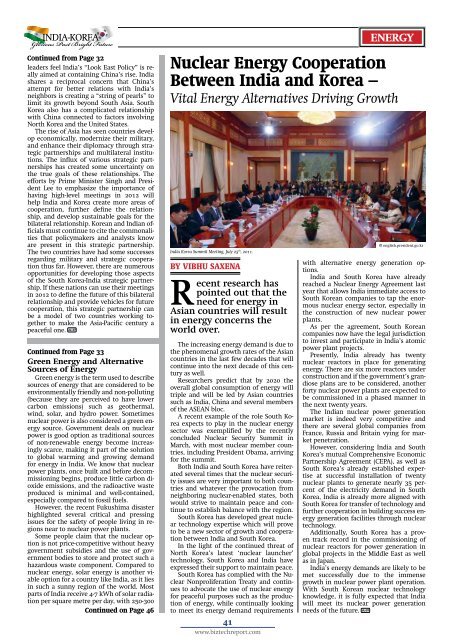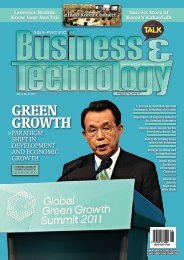INDIA-KOREA - Asia-Pacific Business and Technology Report
INDIA-KOREA - Asia-Pacific Business and Technology Report
INDIA-KOREA - Asia-Pacific Business and Technology Report
Create successful ePaper yourself
Turn your PDF publications into a flip-book with our unique Google optimized e-Paper software.
<strong>INDIA</strong>-<strong>KOREA</strong><br />
Glorious Past Bright Future<br />
Continued from Page 32<br />
leaders feel India’s “Look East Policy” is really<br />
aimed at containing China’s rise. India<br />
shares a reciprocal concern that China’s<br />
attempt for better relations with India’s<br />
neighbors is creating a “string of pearls” to<br />
limit its growth beyond South <strong>Asia</strong>. South<br />
Korea also has a complicated relationship<br />
with China connected to factors involving<br />
North Korea <strong>and</strong> the United States.<br />
The rise of <strong>Asia</strong> has seen countries develop<br />
economically, modernize their military,<br />
<strong>and</strong> enhance their diplomacy through strategic<br />
partnerships <strong>and</strong> multilateral institutions.<br />
The influx of various strategic partnerships<br />
has created some uncertainty on<br />
the true goals of these relationships. The<br />
efforts by Prime Minister Singh <strong>and</strong> President<br />
Lee to emphasize the importance of<br />
having high-level meetings in 2012 will<br />
help India <strong>and</strong> Korea create more areas of<br />
cooperation, further define the relationship,<br />
<strong>and</strong> develop sustainable goals for the<br />
bilateral relationship. Korean <strong>and</strong> Indian officials<br />
must continue to cite the commonalities<br />
that policymakers <strong>and</strong> analysts know<br />
are present in this strategic partnership.<br />
The two countries have had some successes<br />
regarding military <strong>and</strong> strategic cooperation<br />
thus far. However, there are numerous<br />
opportunities for developing those aspects<br />
of the South Korea-India strategic partnership.<br />
If these nations can use their meetings<br />
in 2012 to define the future of this bilateral<br />
relationship <strong>and</strong> provide vehicles for future<br />
cooperation, this strategic partnership can<br />
be a model of two countries working together<br />
to make the <strong>Asia</strong>-<strong>Pacific</strong> century a<br />
peaceful one. A-P<br />
Continued from Page 33<br />
Green Energy <strong>and</strong> Alternative<br />
Sources of Energy<br />
Green energy is the term used to describe<br />
sources of energy that are considered to be<br />
environmentally friendly <strong>and</strong> non-polluting<br />
(because they are perceived to have lower<br />
carbon emissions) such as geothermal,<br />
wind, solar, <strong>and</strong> hydro power. Sometimes<br />
nuclear power is also considered a green energy<br />
source. Government deals on nuclear<br />
power is good option as traditional sources<br />
of non-renewable energy become increasingly<br />
scarce, making it part of the solution<br />
to global warming <strong>and</strong> growing dem<strong>and</strong><br />
for energy in India. We know that nuclear<br />
power plants, once built <strong>and</strong> before decommissioning<br />
begins, produce little carbon dioxide<br />
emissions, <strong>and</strong> the radioactive waste<br />
produced is minimal <strong>and</strong> well-contained,<br />
especially compared to fossil fuels.<br />
However, the recent Fukushima disaster<br />
highlighted several critical <strong>and</strong> pressing<br />
issues for the safety of people living in regions<br />
near to nuclear power plants.<br />
Some people claim that the nuclear option<br />
is not price-competitive without heavy<br />
government subsidies <strong>and</strong> the use of government<br />
bodies to store <strong>and</strong> protect such a<br />
hazardous waste component. Compared to<br />
nuclear energy, solar energy is another viable<br />
option for a country like India, as it lies<br />
in such a sunny region of the world. Most<br />
parts of India receive 4-7 kWh of solar radiation<br />
per square metre per day, with 250-300<br />
Continued on Page 46<br />
Nuclear Energy Cooperation<br />
Between India <strong>and</strong> Korea –<br />
Vital Energy Alternatives Driving Growth<br />
India Korea Summit Meeting, July 25 th , 2011.<br />
by Vibhu Saxena<br />
Recent research has<br />
pointed out that the<br />
need for energy in<br />
<strong>Asia</strong>n countries will result<br />
in energy concerns the<br />
world over.<br />
The increasing energy dem<strong>and</strong> is due to<br />
the phenomenal growth rates of the <strong>Asia</strong>n<br />
countries in the last few decades that will<br />
continue into the next decade of this century<br />
as well.<br />
Researchers predict that by 2020 the<br />
overall global consumption of energy will<br />
triple <strong>and</strong> will be led by <strong>Asia</strong>n countries<br />
such as India, China <strong>and</strong> several members<br />
of the ASEAN bloc.<br />
A recent example of the role South Korea<br />
expects to play in the nuclear energy<br />
sector was exemplified by the recently<br />
concluded Nuclear Security Summit in<br />
March, with most nuclear member countries,<br />
including President Obama, arriving<br />
for the summit.<br />
Both India <strong>and</strong> South Korea have reiterated<br />
several times that the nuclear security<br />
issues are very important to both countries<br />
<strong>and</strong> whatever the provocation from<br />
neighboring nuclear-enabled states, both<br />
would strive to maintain peace <strong>and</strong> continue<br />
to establish balance with the region.<br />
South Korea has developed great nuclear<br />
technology expertise which will prove<br />
to be a new sector of growth <strong>and</strong> cooperation<br />
between India <strong>and</strong> South Korea.<br />
In the light of the continued threat of<br />
North Korea’s latest ‘nuclear launcher’<br />
technology, South Korea <strong>and</strong> India have<br />
expressed their support to maintain peace.<br />
South Korea has complied with the Nuclear<br />
Nonproliferation Treaty <strong>and</strong> continues<br />
to advocate the use of nuclear energy<br />
for peaceful purposes such as the production<br />
of energy, while continually looking<br />
to meet its energy dem<strong>and</strong> requirements<br />
41<br />
www.biztechreport.com<br />
ENERGY<br />
© english.president.go.kr<br />
with alternative energy generation options.<br />
India <strong>and</strong> South Korea have already<br />
reached a Nuclear Energy Agreement last<br />
year that allows India immediate access to<br />
South Korean companies to tap the enormous<br />
nuclear energy sector, especially in<br />
the construction of new nuclear power<br />
plants.<br />
As per the agreement, South Korean<br />
companies now have the legal jurisdiction<br />
to invest <strong>and</strong> participate in India’s atomic<br />
power plant projects.<br />
Presently, India already has twenty<br />
nuclear reactors in place for generating<br />
energy. There are six more reactors under<br />
construction <strong>and</strong> if the government’s gr<strong>and</strong>iose<br />
plans are to be considered, another<br />
forty nuclear power plants are expected to<br />
be commissioned in a phased manner in<br />
the next twenty years.<br />
The Indian nuclear power generation<br />
market is indeed very competitive <strong>and</strong><br />
there are several global companies from<br />
France, Russia <strong>and</strong> Britain vying for market<br />
penetration.<br />
However, considering India <strong>and</strong> South<br />
Korea’s mutual Comprehensive Economic<br />
Partnership Agreement (CEPA), as well as<br />
South Korea’s already established expertise<br />
at successful installation of twenty<br />
nuclear plants to generate nearly 35 percent<br />
of the electricity dem<strong>and</strong> in South<br />
Korea, India is already more aligned with<br />
South Korea for transfer of technology <strong>and</strong><br />
further cooperation in building success energy<br />
generation facilities through nuclear<br />
technology.<br />
Additionally, South Korea has a proven<br />
track record in the commissioning of<br />
nuclear reactors for power generation in<br />
global projects in the Middle East as well<br />
as in Japan.<br />
India’s energy dem<strong>and</strong>s are likely to be<br />
met successfully due to the immense<br />
growth in nuclear power plant operation.<br />
With South Korean nuclear technology<br />
knowledge, it is fully expected that India<br />
will meet its nuclear power generation<br />
needs of the future. A-P









